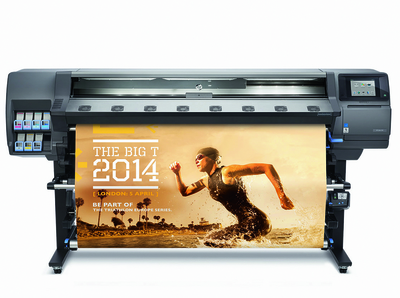The Latex 360 is the top end 1.6 metre model, with built-in spectrophotometer.
The Latex 300 wide format inkjets allow HP to compete with entry level eco sol printers for the first time. Simon Eccles looks at what they offer.
Latex ink is the Marmite of the wide format world: you either love it or hate it. Many people love it because it is as versatile as eco-solvent inks but with instant drying with no outgassing, no-VOC, is water based and has recyclable green credentials, does not smell and has generally greater ease of use. The ink can cost less per square metre than eco sol too.
Others are not convinced: they usually point to the high heat generation of the drying/curing process, which bumps up your electricity bills while limiting what media you can print on. The early inks were fade resistant but not as scratch resistant as solvent or UV inks, though this has been improved since.
HP invented the Latex market (largely by inventing the name as well as the ink) with the high end, high volume 2.6 metre Designjet L65500, announced at drupa 2008. It has progressively expanded the range with smaller models as well as last year’s new flagship, the 3.2 metre Latex 3000.
In April it announced its lowest-cost, smallest model to date. The Latex 310 is the entry point in the new Latex 300 family (the Designjet name was dropped for these printers last year, to emphasise the ink type), offering 1.3 metre (54 inch) width and between 5 and 48 square metres per hour throughput, depending on quality settings.
With a price of just £10,660 including a RIP, the 310 pitches Latex for the first time against the entry-level eco solvent workhorses offered by Mimaki, Mutoh and Roland DG.
It is intended for offices and small design studios as well as ‘garage-based’ small printers who will typically be starting up or expanding into outdoor work from a previous aqueous photo/poster operation.
The other models are Latex 330 and 360, both with 64 inch widths and marginally higher speeds, but with the 360 adding a built-in spectrophotometer for media profiling. Costing about £13,800 and £17,770 respectively, these two replace the older DesignJet 260, which was a little smaller but cost more.
There is more to these new models than lower prices, as they also address some of the Marmite issues of the earlier models. In particular, they use the third generation Latex inks that were first seen last year in the top end Latex 3000. They are said to be much more scratch resistant than before, which makes them better suited to vehicle wraps.
A new primer has been added to the ink set, which lets them cure at 10 to 15 degrees C lower than before. The other inks are CMYK +lc +lm. There is no white option on any HP Latex printer. The original energy-hungry radiant heat drier over the print bed is replaced with a recirculating hot air system. This uses less power and also allows faster warm-up from sleep, so the printer can be powered down more often during the working day. Indeed, the small Latex 310 runs off a single domestic 13 amp plug. The 330 and 360 need 16-amp supplies and plugs.
Lower curing temperatures mean that thinner and less heat-sensitive media can be printed, especially self-adhesive vinyls. Thinner means cheaper, so this is an all-round benefit.
HP’s Latex printers all use thermal print heads, which have a relatively short lifetime (only one litre of ink is guaranteed, but some users report four to five litres) but are cheap and easy to replace: each of the seven heads costs about £90. The ink itself costs just over £100 per 750 ml cartridge.
Mimaki has a similar water-polymer ink that it also calls Latex, but it is a different formulation. So far Mimaki only offers Latex ink in its JV400LX printer, available in 1.37 and 1.62 metre versions for £17,995 and £19,995 respectively. Ricoh also sells rebadged Mimaki based printers and ink as its L4100 models.
Despite their apparent similarity, HP and Mimaki are aiming for different markets. The HP Latex 300 family is intended to handle everything from textiles to banners to vehicle wraps, largely because HP has bet the farm on its thermal head technology and these can only handle water based inks.
Mimaki uses piezo based heads and apart from Latex ink it also has eco sol, SUV (solvent UV hybrid) and UV cured ink models to serve the different purposes that HP aims to cover with one type. It targets its latex models more narrowly, at indoor, high colour quality and backlit applications.
With its new low end models extending its appeal into small printers, HP has set itself the target of winning a 50% market share for Latex by 2016, though it does not say exactly what it is counting as the total market. Ever-better UV and eco sol inks, together with the new SUV hybrids, will prove tough competition. HP has a huge market presence, but will that be enough? Ultimately it will come down to costs and results.





